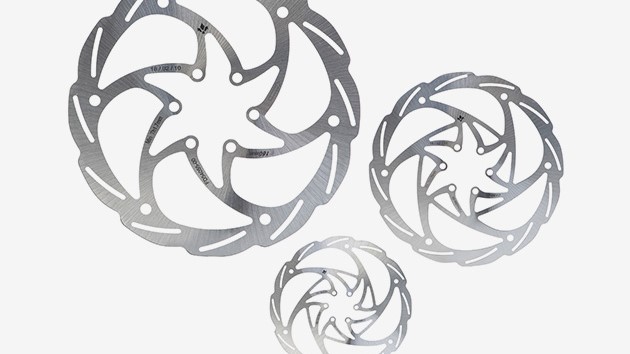Why brake size matters
Brake rotors come in a variety of sizes, but is bigger necessarily better?

Brakes are the most powerful component on your mountain bike, but is going bigger always better?
The ability of a light lever squeeze to enact huge braking forces at the wheels, is one of the most impressive mechanical features in mountain biking.
We tend to take our brake specification for granted, until there is fade or horrible squeal, on a long descent. But should you actively be rethinking your brake rotors in terms of size?
The simplest brake upgrade, to gain sheer stopping power, is upsizing rotor size. You can exchange brake pads, experimenting with different material compounds for feel and durability, but rotor size has a much more significant influence on absolute brake performance.
Before discussing the merits and debits of large brake rotors, a quick mechanical engineering recap about what mountain bike disc brakes do.
To slow your bike down, you need to convert its rolling momentum into a different kind of energy. The hydraulic brake system enables us to use friction, converting rotational energy from your wheels to heat.
The more heat your brake rotors can absorb, the longer they’ll retain stopping power, without fading. By that token, bigger brake rotors must be better? Well, they are, but not for all applications.
Bigger brakes can blunt lever feel
Mountain bike brake rotors are generally sized from 140- to 203mm. Most mid-travel bikes have a 160mm at the rear and 180mm up front.
The obvious question is, why not run 180mm front and rear? Or even 203mm at the front? A simple answer: modulation.
Although larger brake rotors are more powerful and durable in their performance, when descending very steep terrain, they can be too powerful for flatter, flowing trails or terrain that isn't tacky.
In dusty summer riding conditions, a 203mm brake rotor will react with great immediacy to even the slightest lever input. But it can also lock-up way too easily, effectively making your bike’s brakes strong on absolute power, but very weak and uninspiring in terms of lever modulation.
Brake-induced front wheel lock-up means you have no steering control, which increases the probability of a crash in technical terrain.
For most riders, modulation is of greater importance than actual braking power. It is a rare instance that riders pull on a brake lever with force and don’t feel a safe reduction in wheel speed.
- Best mountain bike upgrades
- Shimano developing ABS system
- Why a skills clinic is your best MTB upgrade
Larger riders and long descents
Upsizing your brake rotors can be appropriate if you are a large rider or progressing your mountain biking, by attempting longer, steeper and more technical descents. It is best to upsize the front and usually leave the rear brake rotor size at manufacturer specification, as most of your descending brake force is focussing on the front wheel.
Rear wheel lock-up is tolerable, as it doesn’t influence steering stability. Some riders prefer an easily lockable rear-wheel brake set-up. This allows them to skid sideways through tight switchbacks, as a substitute for the advanced enduro-turn technique, where the rear wheel is lifted, and the entire bike rotates into a turn on its front wheel.
An interesting qualification in the brake-rotor-size debate, is the notion of actively downsizing your rotors.
If you are a lighter rider and want to experiment with improving your brake technique by mastering modulation, there is an argument that riding for a month or two with smaller brake rotors could be beneficial. With less braking power at the wheels, but greater modulation at the braking system’s touchpoints, you could undo some of the bad brake-dragging habits which larger rotors (with their fade-free nature) allow us to develop.

Lance Branquinho is a Namibian-born journalist who graduated to mountain biking after injuries curtailed his trail running. He has a weakness for British steel hardtails, especially those which only run a single gear. As well as Bike Perfect, Lance has written for MBR.com, Off-Road.cc and Cycling News.
